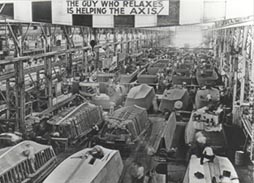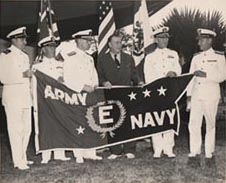Here's to a tactical nuclear softening up for any future amphibious landing on contested ground.

29th Division Monument Camp Blanding, Florida

29th Division Monument Veirville, France







In September, 1943, when the United States Fifth Army landed at Salerno, Italy, and General Douglas MacArthur's forces captured Salamaua in New Guinea, the American navy totaled 14,072 vessels. Of these boats, 12,964, or 92% of the entire U.S. Navy, were designed by Higgins Industries, Incorporated; 8,865 were built at the Higgins plants in New Orleans, La.
Founder and president of this remarkable company was Andrew Jackson Higgins, an outspoken, rough-cut, hot-tempered Irishman with an incredible imagination and the ability to turn wild ideas into reality. He hated bureaucratic red tape, loved bourbon, and was the sort who tended to knock down anything that got in his way. To the Navy's Bureau of Ships, which favored the big Eastern-seaboard shipyards, Higgins was an arrogant small boat builder from the South - a thorn in its side. To the Marine Corps, which desperately needed an effective amphibious assault craft, he was a savior.
Higgins rose to international prominence during World War II for his design and mass production of naval combat motorboats - boats that forever changed the strategy of modern warfare. Thanks to Higgins, the Allies no longer had to batter coastal forts into submission, sweep harbors of mines, and take over enemy-held ports before they could land an assault force. "Higgins boats" gave them the ability to transport thousands of men and hundreds of tons of equipment swiftly through the surf to less-fortified beaches, eliminating the need for established harbors.
Higgins designed and produced two basic classes of military craft. The first class consisted of high-speed PT boats, which carried antiaircraft machine guns, smoke-screen devices, depth charges, and Higgins-designed compressed-air-fired torpedo tubes. Also in this class were the antisubmarine boats, dispatch boats, 170-foot freight supply vessels, and other specialized patrol craft produced for the Army, Navy and Maritime Commission.
The second class consisted of various types of Higgins landing craft (LCPs, LCPLs, LCVPs, LCMs) constructed of wood and steel that were used in transporting fully armed troops, light tanks, field artillery, and other mechanized equipment and supplies essential to amphibious operations. It was these boats that made the D-Day landings at Normandy, Guadalcanal, Tarawa, Iwo Jima, Okinawa, Leyte and Guam and hundreds of lesser-known assaults possible. Without Higgins' uniquely designed craft there could not have been a mass landing of troops and material on European shores or on the beaches of the Pacific islands, at least not without a tremendously higher rate of Allied casualties.
As late as 1930 Higgins was involved in the lumber importing and exporting business. By 1940 he was producing workboats and prototype landing craft in a small warehouse located behind his St. Charles Avenue showroom. When the government began ordering his craft for military purposes, Higgins expanded into eight separate plants in the city, employing more than 20,000 workers. At the peak of production, the combined output of his plants exceeded 700 boats a month. His total output for the Allies during World War II was 20,094 boats, a production record for which Higgins Industries several times received the Army-Navy "E", the highest award that the armed forces could bestow upon a company.
Higgins was the ideal person for the needs of the time. In World War II, with its massive contracts, his strengths - design and rapid production - were all-important. Administrative weaknesses were suddenly irrelevant - the war offered him opportunity. Had the Japanese not bombed Pearl Harbor, Higgins probably would have remained a successful, but small, southern boat builder. Because of the war, he rapidly became an internationally known figure (even Hitler was aware of Higgins, calling him the "new Noah").
In his 1944 Thanksgiving Day address to the nation, General Dwight D. Eisenhower said "Let us thank God for Higgins Industries, management, and labor which has given us the landing boats with which to conduct our campaign." Andrew Jackson Higgins' influence on amphibious warfare and his contribution toward the Allied victory in World War II cannot be overstressed.

The PA33-21 Higgins boat (LCVP) on display in the Louisiana Memorial Pavilion of the National D-Day Museum.
The Higgins Boat was a 36 foot wooden boat designated as a Landing Craft Vehicle, Personnel (LCVP). The LCVP was used to ferry troops, small vehicles and supplies from an anchored transport ship to the beach and back. The design by Andrew J. Higgins was awarded US Patent # 2,341,866 on 15 February 1944.
On a typical run to the beach, an LCVP could carry 36 combat troops or about 8,000 pounds of supplies. They were 36 feet 3 inches in length and 10 feet 10 inches in width (the "beam" in nautical talk). Their displacement was about 9 tons and they could make about 12 knots under load. They were powered by a six cylinder, water cooled Gray Marine Diesel engine generating 225 HP turning a single propeller.
One of the more interesting aspects of the LCVP was their shallow draft. For a boat as large as the LCVP, they only drew 3 feet of water at the stern, 2 feet midships, and an incredible 2 inches at the bow. The standard crew compliment was a coxswain (the "driver"), a motor mechanic, and two other crewmen, one for the bow hook and one for the stern hook (these hooks were used to raise and lower the boat into the ship and for other purposes.)
[Editor's note: This photograph is courtesy of the New Orleans Public Library. It was originally published by Higgins Company in their "The Eureka News Bulletin" in the spring of 1944. Click on the photo for a link to their feature page on the Higgins Boats.]
The boats were carried on the deck of their transport and were lowered into the water by the ship's cranes. Once in the water, the boats were filled with troops via nets hung over the side of the ship or the cranes were used to fill them with other supplies. On command, the boats headed for their designated landing spots on the beach.
The LCVP had a large ramp in the bow that dropped as the boat approached the shore. In theory, the ramp would drop onto a sandy beach and allow the troops to disembark rapidly. In practice, the coral reefs of the Pacific often meant that the troops would have to leave the boat as much as 100 yards from the shore. Due to the weight of their combat gear, the depth of the water, and the proximity of hostile forces, many died before reaching the beach.
On leaving the beach, now loaded with returning troops, or wounded, the two crewmen would manually crank the ramp up, sometimes under fire from the shore. The boat would back out, turn and head for the ship.
The boats were lightly armored on the ramp and from the ramp back to the coxswain's position. The armor plating was typically quarter inch steel which was only effective against small arms fire. The boats also carried two .30 caliber machine guns for self defense.
Higgins Industries produced the majority of the LCVPs used during WWII but the design was licensed to 21 other manufacturers who produced a total of 23,398 of these remarkable boats during the course of the war.

God Bless